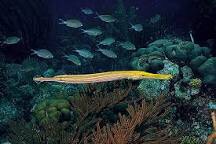Today was our first day on the 2016 week 2 BVI trip. After a long day of traveling yesterday, we started our day early again, getting up at 6:30 and leaving Guavaberry (the place we are staying) at 7am. We then ate breakfast at the restaurant on the marina. Finally, we got to start the main actives for they day. We loaded up the boat with our scuba equipment and went out to our first site. Our capitan, Zoltan, took us to the “dog islands” so called because when explorers first arrived in the area, they heared barking on the islands. However it turns out that the cause of this barking were not dogs, but actually seals. Unfortunately, we saw no seals today because pirates hunted them into extinction a few hundred years later. In our initial dive, we reviewed the basic scuba skills which we learned when we got certified. On our second and in my opinion more exciting dive, we went to a new dive site and reviewed many of the fish species that we learned in the classroom. Many of us got to see these fish species for the first time in real life. For example, I got to see a trumpet fish (pictured below) and a reef squid for the first time. We got to see many other more common species as well including parrot fish, wrass, and sea bass.
Afterwards, we took the boat back to Virgin Guarda(the island where we are staying), and ate lunch at the beach near Guavaberry. We played at the beach for a while and then all of us snorkeled with our instructors to “the baths.” The baths were a series of large rock formations. There, We got to learn a lot about the natural as well as human history of the islands. For example, I leaned the the islands had been formed by techtonic plates pushing against eachother, as opposed to by a volcanoe. Thus, most of the rock on the island was metamorphic rock, not igneous rock. In fact, you can even see the layers of rock that had been pushed together by pressure and heat underground. The baths got its name because it was the place that slaves would be bathed before being sold. There were many sugar plantations on the island from the 1600s to the 1800s and therefore there was a large slave market. There were also interesting holes in the rock formations. We learned that these were gas bubbles that had been fomed when the rock was deep within the ground millions of years ago. We then snorkeled back to the initial beach and returned home.
I am really looking forward to staring our experiment tomorrow. As mentioned in my last blog post, my team and I will be looking at a correlation between the number of parrot fish and algal growth. This is important because algae may take resources from the coral. Since coral are the promary producers of the reef, this is vital to the overall health of the reef.




